Is Microsoft a monopoly? Has Microsoft been guilty of monopolistic behavior?
These are questions we’ve been asking for well over a decade, and the subject surfaced again this week [mid March 2008] after the US Supreme Court cleared the way for Novell to file an antitrust case against the Redmond behemoth over the way WordPerfect was squeezed out of the market.
Therein lies a tale, and every side puts its own spin on things. Microsoft claims that WordPerfect fell into disfavor because it came late to Windows; Novell, which owns the WordPerfect Office technology (after selling the rest of the company to Corel), claims that Microsoft unfairly used its knowledge of Windows APIs to give itself a competitive advantage.
There’s one very solid piece of evidence in Novell’s favor – a 1994 email from Bill Gates that states:
“I have decided that we should not publish these extensions. We should wait until we have a way to do a high level of integration that will be harder for likes of Notes, WordPerfect to achieve, and which will give Office a real advantage . . . We can’t compete with Lotus and WordPerfect/Novell without this.”
Background
Microsoft has always used its existing products to leverage its new ones. It got a contract to produce DOS for IBM because IBM wanted Microsoft’s BASIC interpreter on the IBM PC. Windows was initially designed as a shell for MS-DOS, so PC users could adopt Windows and still access all of their existing software. Word for Windows built upon the foundation laid by Word for DOS, and Excel took over Microsoft’s portion of the spreadsheet market created by Multiplan.
WordPerfect did the same thing, porting its word processor to several platforms and creating its own office suite. And Lotus did the same thing, leveraging the ubiquity of Lotus 1-2-3 to get its foot in the door with Notes and other products. Apple does it today, leveraging the coolness of the iPod to give the Mac a broader market and turn the iPhone into the runaway technology hit of 2007.
The problem isn’t that Microsoft used its strengths in one area to come to dominance in others. The issue is that Microsoft didn’t create a level playing field. WordPerfect, Lotus, and others didn’t have access to certain APIs (application calls) built into Windows that Microsoft didn’t share with the rest of the industry.
And Windows kept changing (evolving from 1.0 to 2.0 to 3.0 to 3.1 to 95 to 98 to Me to XP to Vista), and Microsoft always knew about new APIs long before other developers did. It’s difficult to find exact numbers for Windows market share during the early 1990s, but by 1995 many (who didn’t use Macs) considered Windows 95 to be on a par with the Mac OS, and by 1998 Windows was the default operating system (OS) of all x86 PCs. DOS had been displaced.
Word Processing
There were two “killer apps” in the early days of personal computing, word processing and spreadsheets. Where WordStar had dominated until 1985 (and even been the largest software company circa 1993-94), WordPerfect, introduced in 1982, grew to replace it as the dominant writing platform. And with the rise of Windows, Microsoft took the largest piece of the pie. Microsoft Word owns the market to this day. (WordStar didn’t come to Windows until 1991, and WordPerfect waited until late 1992 to release its Windows version. Word for Windows arrived in 1989, about a half-year before Windows 3.0.)
Stan Liebowitz of the University of Texas at Dallas has done a lot of research in this area, and the charts accompanying this article are adapted from his data. The first chart shows word processor market share from 1986, when Windows was at version 1.0, through 1997. You can see how Word Perfect once dominated the market, rising to almost 50% market share in 1990.
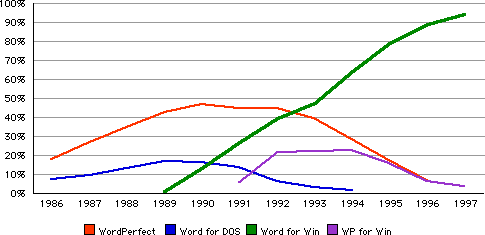
PC word processing market share in units, 1986-1997.
Microsoft Word had been a DOS program since late 1983 and a Mac program since 1985. Word for Windows arrived in November 1989, and it had very little market share initially, as the DOS market was slow to migrate to Windows. Windows began to come into its own with the release of version 3.0 in May 1990, and Windows 3.1 (released in April 1992) was long the standard version of Windows. Still, it’s hard to know how many Windows users there were in those days, as it was shipped with many PCs along with MS-DOS, and most users were still wed to DOS software.
It didn’t take long for Word for Windows to eclipse its DOS ancestor: In its first full year on the market, they matched in sales, and from the point forward the DOS version faded away while the Windows version grew to the #1 spot in 1992 and over half the market in 1994.
WordPerfect held its own as long as DOS was dominant, and it had to develop a Windows version without the inside information that only Microsoft’s development team had access to. WordPerfect for Windows came to market in 1991, and between the DOS and Windows version it outsold Word for Windows in 1992. However, as Liebowitz’ numbers show, WordPerfect for Windows never had half the share the DOS version had once held, and by 1997 Microsoft had a near monopoly with well over 90% of the word processing market.
I don’t think it’s any surprise that WordPerfect began its decline the same year that Windows 95 was released. The 32-bit version, WordPerfect 7, didn’t make it to market until nine months after Win95 had been released, and WordPerfect wasn’t allowed to use the “Designed for Windows 95” logo on it packaging. To make matters worse, WP7 was initially incompatible with Windows NT, the new “server” version of the operating system.
WordPerfect never recovered, and that’s why Novell is going up against Microsoft.
Spreadsheets
Things weren’t much different in the realm of spreadsheets. Where Visicalc had dominated in the 8-bit era of personal computing, Lotus 1-2-3 dominated the DOS era. Microsoft’s Multiplan spreadsheet was a decent product, but Lotus was entrenched. Liebowitz’ research shows Lotus 1-2-3 holding nearly 70% of the spreadsheet market in 1988, with Microsoft Excel and Borland Quattro each at about 10% of the market.
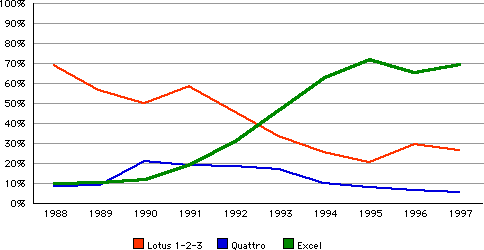
PC spreadsheet market share by units, 1988 to 1997.
Look at the growth curve for Excel. Compare it to the one for Word for Windows. Both were helped by several factors: the growing success of Windows, Microsoft’s access to “secret” APIs, ever increasing feature sets (with promises to duplicate every feature any competitor had), and bundling. Then as now you could buy Microsoft Office for a lot less than the cost of the individual applications.
It was all downhill for Lotus starting in 1992, and Excel outsold it in 1993. By the time Windows 95 reached the market, Excel had about 70% of the market – a market it continues to dominate.
The Mac Side
If you think Microsoft had a huge market share on the PC side, you may be surprised to learn that Microsoft Word and Excel were even more dominant on the Macintosh. That’s right – even without the benefit of “secret” APIs, Microsoft came to dominate the only alternative commercial platform to survive and grow in a world dominated by Windows.
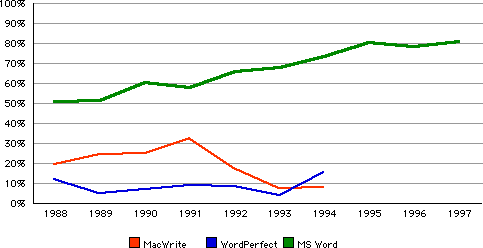
Mac word processor market share by units, 1988 to 1997.
The first Macs shipped with MacWrite and MacPaint, both adequate programs – and both soon overshadowed by commercial alternatives. Liebowitz’ data goes back to 1988, when Word was already outselling MacWrite better than two-to-one. By 1991, MacWrite had clawed its way to over 30% market share, but it was all downhill from there. To this day Word has 80% of the Mac word processing market.
That’s nothing compared with Microsoft’s complete dominance in the Mac spreadsheet market, where it has been the top choice since version 1.0 was announced with the original Macintosh in 1984. As this chart shows, not even Lotus could make a dent in the market. Excel accounts for nearly 100% of the Mac spreadsheet market.
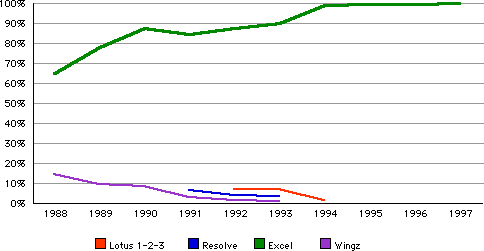
Mac spreadsheet market share in units, 1988 to 1997.
The Big Picture
Worldwide, over 90% of all personal computers run Windows. As Windows has grown its market share, Microsoft has also grown its market share in the word processing and spreadsheet markets – unfairly, according to Novell and many observers.
There are several ways to dominate a market: being first to market, offering a superior product, undercutting competitors on price, promises of future features, and using inside information among them. Microsoft Word was not the first DOS word processor or the dominant one, but with the advent and growth of Windows, Word for Windows became the dominant player by being the first to market, using unpublished APIs, and constantly promising feature parity with any competitor.
Word wasn’t the first word processor for the Mac, but it was the first professional grade one. By the time MacWrite II came to market, Word’s position was assured. And, as on the PC side, Microsoft always promised that every cool feature the competition had would become part of the next revision to Word.
Back on Windows, it took a long time for Excel to dethrone Lotus 1-2-3. One factor here was bundling: You could buy Office for less than the cost of Word plus Excel, which made Excel cheaper than Lotus 1-2-3, since everyone was going to buy Word anyhow.
On the Mac side, Excel was the first spreadsheet, and it’s never had any serious competition. The chart below shows how Microsoft Word and Excel grew market share and came to monopolize their markets on both the Mac and Windows platforms (PC Word includes DOS and Windows versions).
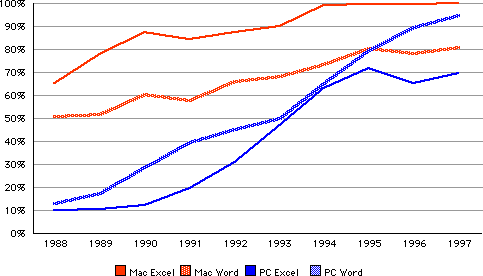
Word and Excel market share on Mac and Windows, 1988 to 1997.
Some take this as evidence that Microsoft didn’t need “secret” APIs to dominate the field. After all, it did the same thing on the Mac, where it had the same access to developer information as anyone else.
The problem with that argument is that it ignores the reasons a program becomes dominant. On the Mac, Word continued in development while MacWrite fell behind, and none of the alternative word processing programs were ever able to take a big bite out of Microsoft’s market.
On the spreadsheet side, Microsoft had the advantage of being first to market on the Mac. Apple didn’t bundle a “MacCalc” with the Macintosh, so Microsoft had no competition at all as the Mac market developed. Wingz was a decent competitor, but Microsoft already had an installed base, and Excel outsold Wingz better than 4:1 in 1988. Lotus was very late to the Mac, and with Excel then nearing the 90% mark, it never stood a chance.
It took Microsoft longer to dominate on the PC side because it was a more competitive market. WordStar had once been dominant, and WordPerfect was the top choice when Word first came to the DOS market. Microsoft Word only became the top player thanks to Windows, which changed the playing field. Access to unpublished APIs and the Windows development team gave the Word team a real leg up on the competition, allowing Word to hold the “first to market” label on the Windows platform.
It took Microsoft even longer to dominate the spreadsheet market on PCs, again thanks to the switch from DOS to Windows. Here Excel wasn’t first to market, but it was able to leverage itself thanks to the growth of Windows and Word for Windows – and the Microsoft Office bundle, which made it a cheap alternative to Lotus 1-2-3.
Up to the Courts
It will be up to the courts to decide whether Microsoft’s access to unpublished APIs was the factor that tipped the scales against WordPerfect. It’s just as plausible that Microsoft’s ongoing promises of features that would match the competition “real soon now” was enough to topple the market leader. And there’s no denying that Microsoft’s ability to offer an Office Suite with Word and Excel gave it an advantage that neither WordPerfect nor Lotus could really compete with, as each was at heart a one product company.
I believe that Microsoft has a long history of predatory and monopolistic behavior in the software market. DR-DOS, GEM, WordPerfect, Lotus 1-2-3, and Netscape Navigator are just a few of the casualties. It seems the only products that can compete with Microsoft’s today are open source projects, such as Linux, Open Office, and Mozilla – and that Mac operating system, where Microsoft makes piles of money selling Word and Excel.
UPDATE: In 2012, Novell’s antitrust lawsuit against Microsoft was finally dismissed for good following a mistrial in December 2011.
Sources
- Untitled paper examining word processor and spreadsheet share on Mac and PC platforms and Major Markets – WordProcessors and Spreadsheets, Stan Liebowitz, Ashbel Smith Professor of Economics, University of Texas at Dallas
- Original spreadsheets from Stan Liebowitz with the data he used for his published and some unpublished charts.
Keywords: #microsoft #microsoftmonopoly #microsoftword #microsoftexcel #microsoftoffice #microsoftwindows
Short link: http://goo.gl/FyTPx0

